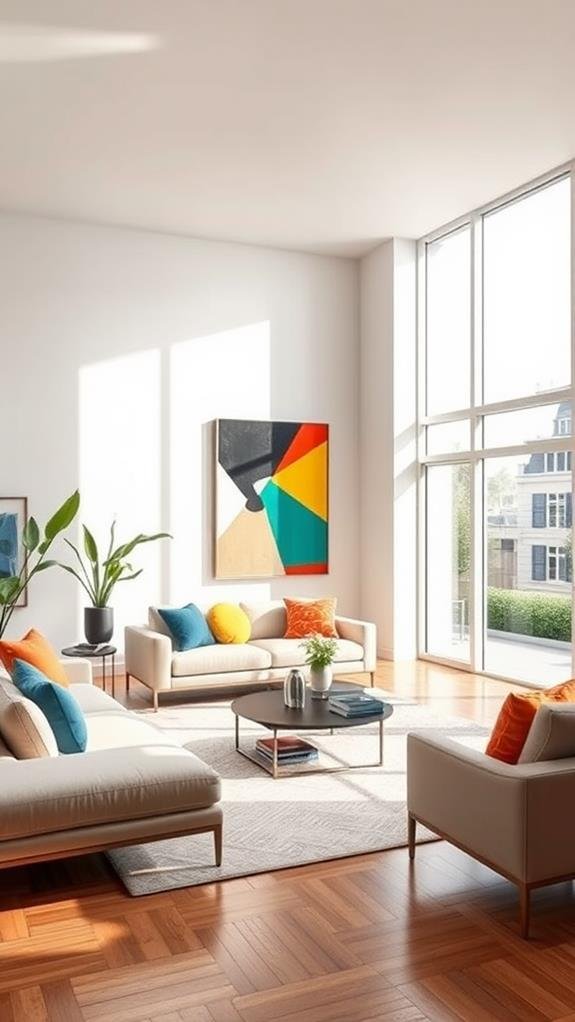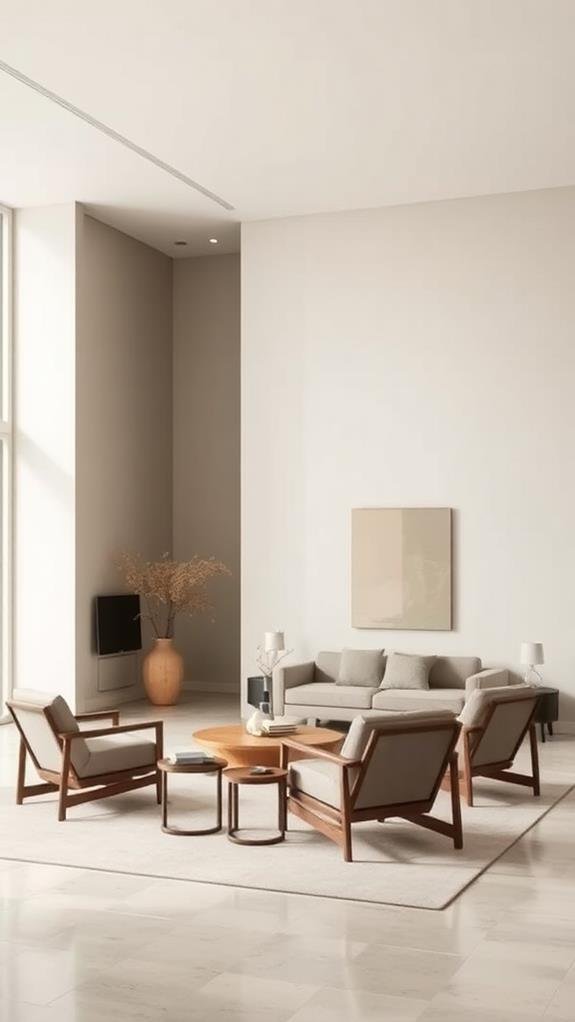Key Principles of Bauhaus Interior Design
The key principles of Bauhaus interior design focus on functionality, simplicity, and the use of innovative materials. You’ll find that “form follows function” is central, meaning everything in a space should serve a purpose while looking good. Clean lines and minimal decor create open environments that feel inviting, enhancing your daily activities. Additionally, art and design merge seamlessly in Bauhaus furniture, turning everyday items into aesthetic pieces. Its emphasis on sustainability encourages using natural, recyclable materials for eco-friendly living. By embracing these principles, you create harmonious spaces that reflect modern life, and there’s much more to investigate about this fascinating style!
Key Takeaways
- Bauhaus design emphasizes “form follows function,” prioritizing practicality alongside aesthetic appeal through simple shapes and clean lines.
- Functionality shapes all design choices, ensuring furniture and decor serve practical purposes while enhancing daily living and comfort.
- Minimalism is key, focusing on uncluttered spaces, neutral colors, and natural materials to create a serene atmosphere.
- Innovative materials like steel and glass are used to enhance beauty and practicality, transforming spaces with durable options.
- Bauhaus principles encourage sustainability by utilizing renewable materials, promoting thoughtful design that minimizes waste and unnecessary products.
Historical Context of Bauhaus

What drove the emergence of the Bauhaus movement in the early 20th century? You’ll find that the world was changing rapidly.
After World War I, people craved new ideas and artistic expression. Cities were expanding, technology advanced, and there was a strong desire for progress.
The Bauhaus was founded in Germany in 1919, aiming to unite art and craftsmanship in a time when they were often seen as separate.
This school attracted talented artists and designers who wanted to rethink how people lived and interacted with spaces. They believed in creating functional, beautiful designs that everyone could enjoy.
This innovative approach inspired a whole new way of thinking about architecture and design, marking a significant shift in the artistic landscape.
Core Philosophy of Bauhaus

The core philosophy of Bauhaus centers on the belief that form should follow function, prioritizing practicality without sacrificing aesthetic appeal. This means that every item you bring into a space should serve a purpose, looking good while doing so.
You’ll notice that Bauhaus design combines simple shapes and clean lines, making spaces feel open and inviting. The idea is to create an environment where functionality reigns supreme, but beauty isn’t ignored.
You’ll appreciate how this approach encourages using modern materials like steel and glass instead of heavy wood or ornate decorations.
Ultimately, Bauhaus invites you to think about how you interact with your surroundings, aiming for a harmonious balance between usefulness and style, ensuring your space reflects both your needs and unique taste.
Importance of Functionality

In the world of Bauhaus interior design, functionality is paramount, serving as the cornerstone of every design decision.
You’ll notice that every piece of furniture and decor is chosen for its usefulness. This means that each item shouldn’t only look good but also serve a practical purpose.
When you create a space, think about how you’ll use it day-to-day. For instance, a chair isn’t just for sitting; it needs to be comfortable and supportive for long periods.
Spaces are designed to support activities, whether relaxing, working, or socializing.
Emphasis on Simplicity

Simplicity is a hallmark of Bauhaus interior design, where every element serves a purpose without unnecessary embellishments. In your home, this means opting for clean lines, minimal decor, and functional furnishings. By focusing on simplicity, you create spaces that feel open and inviting.
Think about using neutral colors and natural materials, which can help maintain a calm environment. You don’t need flashy accessories or complicated designs; instead, choose pieces that make a statement through their functionality.
When you emphasize simplicity, you’re allowing the beauty of each item to shine without competition. Remember, less is often more. By embodying this principle, you’ll achieve a balanced and harmonious space that reflects the true essence of Bauhaus design.
Integration of Art and Design

Art and design seamlessly blend in Bauhaus interior design, creating spaces that inspire and engage. By emphasizing functional beauty, this approach values the connection between artistic expression and everyday living.
You’ll notice how furniture isn’t just about comfort; it also serves as a piece of art. Clean lines and geometric shapes elevate visual appeal while remaining practical for daily use.
The use of color in Bauhaus spaces is intentional, adding vibrancy and depth without overwhelming the senses. You’ll find works of art strategically placed, harmonizing with the furniture and overall space.
This thoughtful integration encourages you to appreciate not only the function of your environment but also its aesthetic qualities, making daily experiences richer and more enjoyable.
Use of Innovative Materials

Innovation drives the use of materials in Bauhaus interior design, showcasing a commitment to creativity and functionality.
You’ll find that this style incorporates modern materials like steel, glass, and plywood, often using them in ways you mightn’t expect. These materials not only improve the beauty of a space but also add practical benefits, such as durability and ease of maintenance.
The Bauhaus philosophy encourages you to think beyond traditional options, integrating new textures and finishes to create unique environments.
For instance, the use of industrial materials transforms ordinary rooms into striking works of art.
Focus on Industrial Production

In Bauhaus interior design, the focus on industrial production shapes how spaces are created and furnished. This approach emphasizes using materials and techniques suited for mass production, making stylish designs more accessible to everyone.
You’ll notice that furniture often features simple, geometric forms, allowing for easy assembly and disassembly. By prioritizing functionality, designers make sure each piece serves a clear purpose while maintaining aesthetic appeal.
Fabrics, metals, and woods are often used in their raw forms, highlighting their natural beauty and structural integrity. This focus on industrial production not only contributes to sustainability but also encourages creativity as designers investigate new ways to integrate innovative manufacturing processes.
Minimalism in Decor

Three key aspects define minimalism in decor within Bauhaus interior design: simplicity, functionality, and intentionality.
First, simplicity means you focus on clean lines and uncluttered spaces. This helps create a soothing and calm environment, making it easier for you to relax.
Next, functionality plays an important role; every piece of furniture should serve a purpose. That way, you eliminate unnecessary items and maximize the use of your space.
Finally, intentionality encourages you to choose decor elements thoughtfully. Instead of filling your room with random objects, select a few meaningful pieces that improve the overall aesthetic.
Spatial Arrangement Techniques

Effective spatial arrangement techniques are essential in Bauhaus interior design, as they improve both functionality and aesthetics.
To create a balanced space, start by considering the flow of movement. Arrange furniture to encourage easy navigation, allowing people to move freely without obstacles. Use symmetry to create a sense of order and harmony; this might mean placing chairs evenly around a table.
Incorporate open spaces to promote a clean look, avoiding clutter and excess furniture. Group similar items together, as this can elevate their visual impact.
Color Theory in Bauhaus

Color theory plays an essential role in Bauhaus interior design, influencing both mood and functionality. In this style, colors aren’t just pretty; they communicate emotions and help create an atmosphere.
You’ll often find bold, primary colors like red, blue, and yellow used to energize a space, while neutral tones can provide balance and calm. By combining these colors skillfully, you can highlight specific areas or even architectural features.
When designing, consider the feelings you want each room to evoke, whether it’s excitement or tranquility. Additionally, Bauhaus emphasizes simplicity, so limit your palette to avoid overwhelming your space.
Understanding color theory helps you create cohesive and inviting interiors that truly reflect your personality and style.
Furniture Design Principles

Incorporating bold colors into your space sets the stage for the furniture design that follows.
Bauhaus furniture focuses on functionality and simplicity, guaranteeing each piece serves a purpose. When choosing furniture, look for clean lines and geometric shapes, as these elements reflect the Bauhaus style.
Lightweight materials, such as metal and plywood, are often used, making the designs both modern and practical. You’ll want to guarantee that the furniture is versatile, allowing you to rearrange your space easily.
Additionally, keep comfort in mind; even minimalist furniture should feel good to use. By selecting pieces that blend functionality with aesthetic appeal, you create a harmonious, inviting environment that truly embodies the essence of Bauhaus design.
Influence on Modern Design

From its inception in the early 20th century, Bauhaus has profoundly influenced modern design across various disciplines.
You may not realize it, but everyday objects like furniture, lighting, and architecture show Bauhaus principles. The emphasis on simplicity, functionality, and clean lines encourages you to see beauty in minimalism. Think about how many products you use daily boast an uncluttered aesthetic—that’s Bauhaus at work!
Additionally, its blend of art and craftsmanship inspires designers to balance creativity with practicality. Whether it’s in a trendy café or your own home, you can spot the unmistakable marks of Bauhaus.
Its teachings remind us that design isn’t just about looks; it’s about making life easier and more enjoyable through thoughtful and efficient solutions.
Sustainability in Bauhaus

Sustainability in Bauhaus emphasizes the importance of eco-friendly practices in design. It encourages you to think about how your choices impact the environment.
By using materials that are renewable, recyclable, or made from natural sources, you’re reducing waste and promoting a healthier planet. Bauhaus design often focuses on simplicity and functionality, which helps you avoid unnecessary products that could clutter your space.
Additionally, incorporating energy-efficient lighting and appliances is a key aspect of sustainable living. When you adopt these principles, you’re not only creating beautiful interiors but also showing a commitment to responsible living.
Impact on Contemporary Interiors

Bauhaus interior design transforms contemporary spaces by emphasizing functionality and minimalism. This influential style encourages you to prioritize practical design elements and clean lines, making rooms feel open and inviting.
You might notice how Bauhaus-inspired interiors often use neutral colors and natural materials, creating a calming atmosphere that promotes relaxation.
In modern homes, furniture and decor are chosen for their utility, often doubling as art pieces. You’ll see how this style eliminates clutter and focuses on what’s essential, making it easier to navigate your space.
Additionally, Bauhaus design encourages collaboration between different artistic disciplines, influencing architects and designers to rethink how they create environments.
Conclusion
To summarize, understanding the key principles of Bauhaus interior design can truly transform your space. By focusing on functionality, simplicity, and the blend of art with design, you can create a home that feels both stylish and practical. Bauhaus also encourages sustainability, which is important for our environment. So, whether you’re rearranging furniture or choosing décor, keep these principles in mind to bring a touch of Bauhaus elegance into your everyday life.


